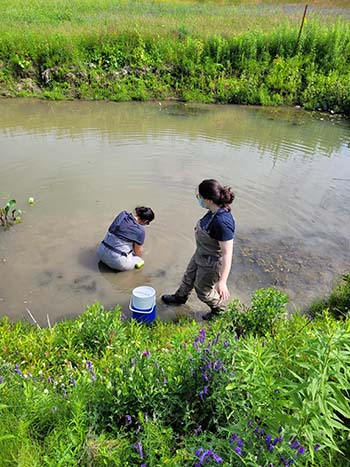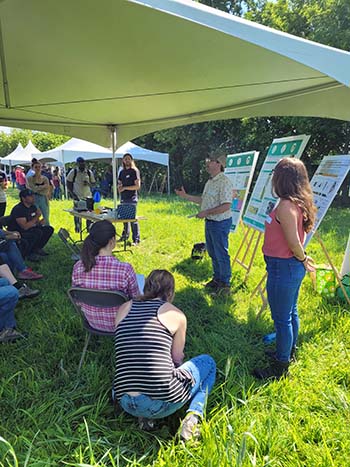For further information:
Media Relations
Agriculture and Agri-Food Canada
1-866-345-7972
aafc.mediarelations-relationsmedias.aac@agr.gc.ca
It’s time to take stock! The 2020-2023 Living Lab – Quebec project, led by the Union des producteurs agricoles, has come to a successful conclusion. Here are the results.
A brief summary of the project
A brief summary of the project The Living Lab – Quebec project was part of the Living Laboratories Initiative (2018-2023). The aim was to apply a living labs approach to agricultural innovation in the Lac Saint-Pierre region, a widening of the St. Lawrence River located between the municipalities of Sorel-Tracy and Trois-Rivières. Led by the Union des producteurs agricoles, Living Lab – Quebec was carried out in collaboration with Agriculture and Agri-Food Canada along with a number of other regional partners.
Farmers, researchers, Indigenous communities and other local partners (see the list of collaborators below) worked closely together in real-life production situations to innovate, share knowledge and co-develop practices to reduce the environmental impact of agriculture. They focused mainly on the health of watercourses, soil health and fertility, and biodiversity in agricultural environments.
The success of this new method for agricultural innovation relies on the close ties between science and the reality of producers and their communities, since work is carried out directly on the farm whenever possible and appropriate. This collaboration fosters innovation and the rapid adoption of beneficial management practices and enables better targeting of scientific research and the sharing of beneficial agricultural technologies.
Innovative ways of working
A number of successes deserve to be highlighted, such as the introduction of innovative ways of working. For example, the creation of theme-based innovation cells (sub-groups of producers, researcher scientists and other project partners) encouraged in-depth exploration of five major themes:
- Soil and fertilizer management
- Development of riparian strips
- Feed and livestock effluent management
- Watercourse management
- Maintenance and reintroduction of key plant species for the W8banaki Nation
This subdivision into cells made it possible to design more specific workshops and facilitated innovation, co-creation, exchanges of experience and the sharing of results and acquired knowledge.
The preparation of personalized individual reports for producers enabled more than 40 farmers and agricultural advisors to deepen their knowledge or become familiar with certain beneficial management practices such as cover crops, reduced fertilizer inputs, riparian strips and their impact on biodiversity, and water management through groundwater control and retention ponds. The farmers greatly appreciated this personalized approach.
Another crucial aspect was the hiring of an open innovation specialist at the start of the project. This expert helped the coordinating team and participants to build a co-creative working environment to support innovative, collaborative activities and to conduct effective co-development workshops. In short, collaboration between all the members of the living lab project and regional organizations has enabled more than 20 on-farm studies to be carried out, which is a great success.
Some clear findings, and others to be explored further
Researchers from the living lab made several findings. The first one is related to riparian strips, which are areas of vegetation along rivers or streams that are often rich with microbial, entomological (pollinators) and avian (birds) diversity. Three types of riparian strips were studied:
- the herbaceous riparian strip, which consists of grasses, mellifers and other low-growing plants
- the shrubby riparian strip, which is often composed of a mixture of shrubs and herbaceous plants
- the arboreal riparian strip, which is made up of trees, shrubs and herbaceous plants
Regardless of the vegetation present in the riparian strips, researchers found that pollinator biodiversity was high, with an average of 21 species per type of riparian strip. While greatly varying between years, the overall diversity of pollinator species present in the strips was equivalent, but the actual species composition differed from one type to another. The vast majority of pollinators found were native, which means that they are well-equipped to pollinate native plants and can have a positive impact at the community level. The type of vegetation established in the strips also influences carbon sequestration, which is faster in the short term under grassland cover and more gradual under shrub and tree cover.
A second finding is about cover crops, which have the potential to supply nitrogen to the next crop and to improve soil health. For the three sites evaluated in 2022, the use of cover crops reduced the optimum nitrogen rate for grain corn production from 36 kg to 8 kg per hectare. At the site where the nitrogen contribution was highest, the release became more significant between early and mid-July, suggesting a later release of nitrogen than initially anticipated with cover crops. Cover crops and intercrops in corn were also found to increase the stability of the soil and its resistance to erosion as well as to decrease soil compaction, thereby improving water and air circulation and root growth conditions. Soils with cover crops also contained more enzymes reducing nitrous oxide, a powerful greenhouse gas. This indicated that cover cropping may decrease the nitrous oxide emission potential of agricultural soils.
As part of the Living Lab – Quebec project, an agroforestry site, which was established in 2012, was sampled in the fall of 2021 by Agriculture and Agri-Food Canada scientists to determine the rate of carbon sequestration and soil quality. The results showed that the rate of carbon sequestration was particularly high in the first 10 years following the establishment of an agroforestry plot. Indeed, the agroforestry plot accumulated 1.3 tons of carbon per hectare per year more than the control plot (without trees) in the first 20 cm soil layer. The diversity of fungi that colonize the roots also increased in the agroforestry plot compared with the treeless control field, which is positive because it facilitates nutrients uptake by the crop.
Researchers have also established that biomethanization of slurry using the low-temperature technology developed by Agriculture and Agri-Food Canada was possible and could therefore be used to produce bioenergy, while having the potential to reduce on-farm greenhouse gas emissions.
Finally, a socio-economic survey of producers in the Lac Saint-Pierre region revealed that the main incentives for adopting environmentally beneficial practices are:
- caring for the environment
- complying with regulations
- improving soil and water quality
- mitigating or adapting to climate change
- increasing farm profitability
Meanwhile, the main barriers are the perceived lack of financial support, the risk of reduced agricultural yields, and the high initial costs.
The adventure continues
The 2018-2023 Living Laboratories Initiative was so successful that Agriculture and Agri-Food Canada has decided to continue its financial support by setting up 14 new living labs projects across the country as part of the Agricultural Climate Solutions – Living Labs program launched in 2021. Since then, Quebec has launched two new projects: Living Lab – Lait carboneutre with Les Producteurs de lait du Québec and Living Lab – Racines d’avenir with the Union des producteurs agricoles. These two projects will enable us to pursue the methods initiated in the Living Lab – Quebec project and contribute to efforts to develop innovations that will sequester and store carbon and reduce GHG emissions, with a view to combating climate change.
“The benefits of the living labs approach have been demonstrated by the positive spin-offs from the country’s first living lab projects. My fellow researchers and I are committed to carrying on the living labs concept with two new projects in Quebec. The entire agricultural sector benefits from the innovative discoveries made by the farmers and scientists involved in these projects.”
– Georges Thériault, Scientific Coordinator, Living Lab – Quebec, Agriculture and Agri-Food Canada
“With the living labs approach, the expertise of farmers is valued equally and in the same way as that of other experts. It’s a winning situation in the long term, to perpetuate the adoption of innovative agricultural practices with positive impacts for farm businesses and the environment.”
– Chantal Foulds, Project Coordinator, Union des producteurs agricoles

Identification of the three sites analyzed in the Lac Saint-Pierre region, located between the municipalities of Sorel-Tracy and Trois-Rivières.
Collaborators
- Agriculture and Agri-Food Canada
- Participating producers from the three watersheds
- Confédération de l'Union des producteurs agricoles du Québec (primary collaborator)
- AGIR-Maskinongé Watershed Organization
- Ducks Unlimited Canada
- Environment and Climate Change Canada
- Fisheries and Oceans Canada
- Fondation de la faune du Québec
- McGill University
- Ministère de l'Agriculture, des Pêcheries et de l'Alimentation du Québec
- Ministère de l'Environnement et de la Lutte aux Changements Climatiques du Québec
- Ministère des Forêts, de la Faune et des Parcs du Québec
- Natural Resources Canada
- Nature Conservancy of Canada
- Regional Fédération de l'UPA-Centre-du-Québec
- Regional Fédération de l'UPA-Lanaudière
- Regional Fédération de l'UPA-Mauricie
- Regional Fédération de l'UPA-Montérégie
- Université du Québec à Trois-Rivières
- Université Laval
- Waban-Aki Nation
Photo gallery

Two research scientists in action in the field, collecting samples and data.

Scientists (Etienne Lord, Jean-Philippe Parent, Jacynthe Masse), producers and partners meet periodically to exchange ideas and learn from each other.